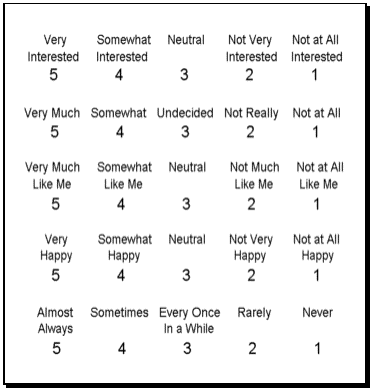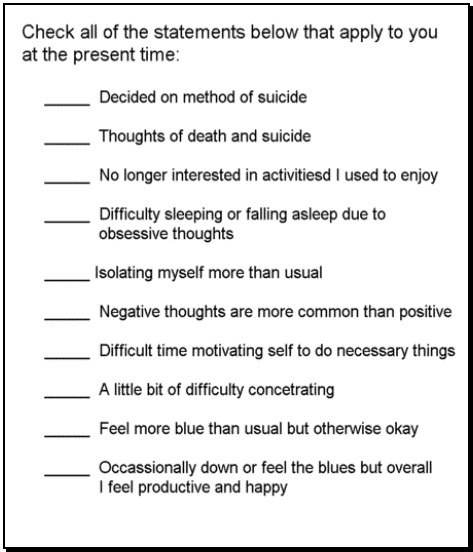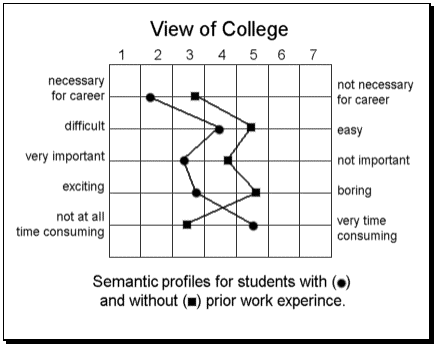
- •Research Tools of the Trade
- •Figure 3.1: Sample Statement of Informed Consent
- •Table 3.1: Checklist for the Statement of Informed Consent
- •Table 3.2: Examples of Five-point Likert Scales
- •Table 3.3: Sample Thurstone Questionnaire
- •Figure 3.2: Research Results of a Hypothetical Semantic Differential Scale
- •Figure 3.3: Sample Outcome of a q-Sort
- •Method Tools of Research
Table 3.2: Examples of Five-point Likert Scales

Thurstone Technique. The Thurstone technique allows subjects to express their beliefs or opinions by checking items that apply to them. It requires that a series of statements, usually 10 or 20, be created by experts in a specific area of interest. These statements are placed in order of intensity or rated in order of intensity by the experts. The subject is then asked to check all of the statements that apply to her and a median score is computed based on which items she has checked. For example, if the subject checked three items that were rated an intensity of four and three items rated an intensity of two, her median score would be 3. The subject who checked higher rated items would receive a higher median score and the subject who checked lower level items would receive a lower median score. Table 3.3 provides a hypothetical Thurstone scale for major depressive disorder with the symptoms starting at the bottom representing low intensity and then progressing upward to the top, which represents high intensity.
Table 3.3: Sample Thurstone Questionnaire

Semantic Differential. Somewhat similar to a likert scale, a semantic questionnaire asks subjects to rate their opinion on a scale representing two extremes and a series of points in between. Unlike the Likert, however, this technique usually provides a total of seven points rather than five, and the points in between the extremes are not labeled. The subject is therefore forced to provide his own rating on a ‘one to seven’ scale only knowing the description of the two extremes. Good examples of these semantic differentials include dichotomies such as extroverted/introverted, friendly/cruel, interested/not interested, or biological/environmental. Figure 3.2 provides an example of what the results of research might look like using a semantic differential technique.
Figure 3.2: Research Results of a Hypothetical Semantic Differential Scale

Observation Forms. Observation of subjects has been a longstanding means of gathering information. While this method works well for informal research or research involving only a single subject, it is not an easy task to generalize to the greater population. Scientific methods require that any observation be as standardized and objective as possible if generalization is to occur. Observation forms are often used to allow researchers to detail their observations on an agreed upon scale and observer ratings are often correlated to determine if all are measuring the same behaviors.
Human behavior is complex and measuring it merely by watching behaviors presents unique challenges. Imagine measuring violent behavior is a group of 3rd graders during recess. What one observer sees as violent, pushing another child for example, a second researcher may view as aggressive but not violent. A third observer may miss the behavior all together due to other behaviors or some distracter on the playground. To increase validity and reliability, the following steps are recommended:
1. Operationally define behaviors to be observed as much as possible
2. Practice observations before the study to correlate results in order to make sure all observers are measuring the same behaviors
3. Use at least two observers per subject when possible in order to minimize missed behaviors or misinterpretations
4. Retrain observers frequently and correlate these training observations.
Q-Sort. The Q-Sort is a technique adopted originally into humanistic psychology as a means for a client to self-evaluate his current status and then decide on treatment goals. Since the instrument is completed and interpreted by the client without the opinion of the therapist, it allows the client to be in complete control of what issues are to be worked on. This follows the humanistic view that the client, not the therapist, is the one with the answers to the client’s problems.
The Q-Sort consists of a number of cards, often as many as 40 or 50, each consisting of a single trait, belief, or behavior. The goal is to sort these cards into one of five columns ranging from statements such as, ‘very much like me’ to ‘not at all like me.’ There are typically a specific number of cards allowed for each column, forcing the client to balance the cards evenly. The qualities in each column are then recorded and the results are used to assist the client in determining issues he or she wishes to work on in treatment. The Q-Sort can also be completed during and after treatment to assess changes and progress toward the self-determined goals.
